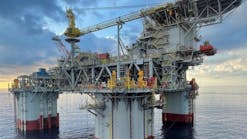Gaz Metro, Anticosti Hydrocarbons sign gas development deal
This article was modified Oct. 24.
Anticosti Hydrocarbons LP has signed a strategic agreement in principle with natural gas distributor Gaz Metro Ltd. Partnership to develop associated gas from Anticosti Island in the Gulf of St. Lawrence offshore Quebec.
Anticosti Hydrocarbons says the agreement provides it with access to Anticosti Island expertise to identify economic, operational, and technical solutions to transporting associated gas to market should any be produced during possible hydrocarbon production on the island. This includes technical issues such as storage, transportation, and distribution.
Gaz Metro will have acquisition rights to any gas produced from wells on the island and be able to transport or distribute it to market, subject to compliance with the terms and conditions in the agreement.
In exchange for Gaz Metro’s expertise, Anticosti Hydrocarbons has agreed to an exclusive partnership with Gaz Metro for the next 5 years.
Anticosti Hydrocarbons is a limited partnership owned by Ressources Quebec with 35% interest, Petrolia Inc. subsidiary Investissements PEA Inc. 21.67%, Maurel & Prom and MPI subsidiary Saint-Aubin E&P (Quebec) Inc. 21.67%, and Corridor Resources Inc. 21.67%.
The board of Anticosti Hydrocarbons consists of one representative from each of the partners and one independent director. The partnership has formed four committees made up of an equal number of representatives from each of the partners.
The partnership’s primary objective is to demonstrate the commercial viability of hydrocarbon resources on its 38 exploration permits covering 6,195 sq km on Anticosti Island.
Corridor in 2012 implemented a program to further define the island’s resource and help select optimal locations for drilling and testing (OGJ Online, Sept. 4, 2012). At the time, independent consultants estimated oil in place in the Macasty shale on the island at 19.8 billion boe net (33.9 billion boe gross) in undiscovered resources.
The following year Corridor said core analyses from Macasty in two wells on the island “are impressive and compare favorably with producing wells from the Utica formation that occurs in the Eastern Ohio region” and are “very positive indicators for the potential production of hydrocarbons from the Macasty formation (OGJ Online, Jan. 18, 2013).”
Petrolia that summer said its core analyses indicate that the shales are favorable for the production of petroleum (OGJ Online, July 15, 2013).
Corridor’s web site summarizes an exploratory program that would cost as much as $100 million and involve the drilling, multistage fracturing, and testing in 2015 of three horizontal wells to delineate oil and gas-condensate potential.
Corridor said Anticosti basin geological objectives lie at 1,200-4,000 m and include the Macasty; the Romaine carbonate stratigraphic equivalent of the Beekmantown, Knox, Arbuckle, and Ellenburger; Trenton/Black River fractured hydrothermal dolomite reservoirs; and the English Head shale equivalent of the Loraine Group of Quebec and New York, all of Ordovician age.
